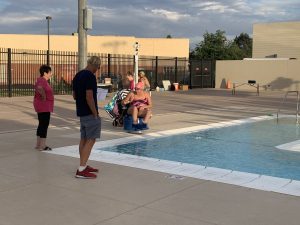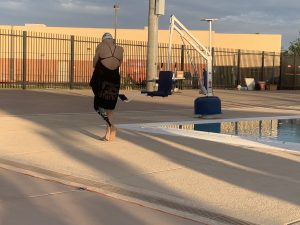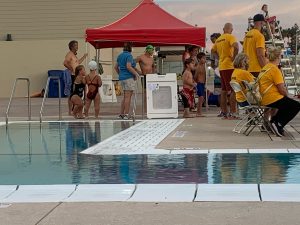- Slug: Sports-Desert Challenge, 1,052 words
- Photos available
By Taiwo Adeshigbin
Cronkite News
MESA – It looked like any other competition at the Kino Aquatic Center, save the assistive devices, including wheelchairs, crutches and prostheses. And for athletes unable to take steps down into the pool, a built-in power lift was available.
From the minute the horn blew to the moment the last person finished, athletes, volunteers and spectators were cheering and clapping.
“Even though she is respected in the swimming community, she’s still the girl with one leg,” Pamela Freeman said of her daughter Liberty. “Going to the Desert Challenge Games, she’s not the only one. Everyone has something.”
The competition, which first took place in 1990, is the first large-scale in-person national athletic event for the disabled in Phoenix since its cancellation last year due to the pandemic. From Wednesday to Sunday, the Desert Challenge Games welcomed 358 athletes from 19 countries who competed in archery, airgun, track and swimming.
Host Arizona Disabled Sports implemented strict health guidelines as some events served as a qualifier for the Tokyo Paralympic Games.
Two families watching their athletes compete were excited to see their children interact with others.
Liberty “Libby” Freeman, 16, competed in the event for the first time, and it didn’t take long for her to stand out. She finished at the top of three events – the 100-meter individual medley, the 50 butterfly and 500 freestyle. Her times qualified her for the junior nationals in Denver this July.
Libby’s quickness recognized quickly when she took her first steps in her prosthesis at 4 years old.
The Tucson family adopted Libby when she was 3 from Tomsk, a city in Siberia, in July of 2009, knowing she was born “without a tibia and a floating fibula,” Pamela said.
After Libby’s above-knee amputation, she was no longer the 4-year-old girl who needed to be carried around. She didn’t need any instruction on how to even walk or run.
“She put (the prosthesis) on and took a few steps and took off running down the hallway,” Pamela said. “She was just so excited to be up that she took off running.”
Her enthusiasm for swimming was no different. At 9, Libby learned how to swim by watching YouTube videos of Paralympic and Olympic athletes to master the different swimming styles.
“She goes online and finds recommended sets and writes them down and swims them at LA Fitness,” Pamela said. “It was not optimal, but it is what we have had to do.”
The closing of pools due to COVID-19, having another leg surgery in February and difficulty finding a coach to work with her disability didn’t stop Libby from training at home and at her local pool.
Even though she enjoys swimming for Marana High School in Tucson, and fits right in, the opportunities to participate in competitions for those with disabilities are limited.
Despite the hurdles, Libby has remained motivated to compete at the highest level thanks to her family, friends and other athletes that share her experiences, like American Paralympic athlete Jessica Long, who also was adopted.
“It has always been a goal to go to the Paralympics,” Libby said. “Swimming is just fun, and it’s a way to express myself.”
That fun was evident after Libby finished the race. The referees jokingly told her to slow down afterward as she struck up conversations with the other participants.
Watching athletes with disabilities dive in and do their best was a pleasure, referee David Brooks said.
Fun is what motivates Mesa swimmer Nathanael Akers.
“The thing that keeps me moving is my family,” he said. “I keep doing this for a reason because I enjoy it. I don’t want to stop. It’s just too fun to stop.”
His mother, Rocio Akers, said Nathanael was diagnosed with arthrogryposis multiplex congenita when she was 12 to 14 weeks pregnant.
AMC is a rare condition that typically presents before birth when a fetus is not able to move normally in the womb. This lack of mobility can result in stiff joints, and limits the function and range of motion of the joint.
“That condition affected his arms, hands and legs. He can’t bend his elbow or grab stuff. He can’t move his fingers,” Rocio said. “It’s more like the ligaments are so tight or short.”
For Nathanael, 11, the condition has affected his arms to a greater extent than his legs. That didn’t hinder him from swimming at age 3.
“I thought he would never be able to swim,” Rocio said. “I was thinking maybe he could learn how to float in case he was at my in-laws’ or a friend’s house.”
Thanks to a swim coach who worked tirelessly with him, Nathanael was swimming within 6 months and has continued since.
“The toughest thing is the temperature of the water,” Nathanael said, laughing. “I’m really picky about the water.”
His legs tend to fatigue quickly because they have to work even harder to compensate for his limited arm use, he said. Still, he finished every event.
The moment he takes a breath above the water he hears his parents yelling, “go, go, go” and that helps keep him going, he added.
Not only did he swim the 100 IM, 50 fly, 50 back, 50 breast, 50 free and the 100 free relay, he also completed in track events: the 100, 200 and 400 meters and long jump.
The celebration for every athlete was what made the Desert Challenge Games different from
competitions for the non-disabled.
“My experience is that disabled athletes cheer for each other, regardless of age, gender or disability,” said Brooks, who has refereed both athletes with and without disabilities. “Everybody involved is just encouraged that they are competing.”
Rocio added that “this program made me feel so grateful because he can see more people with disabilities, and he can see he can do more.”
“Everyone is positive and enthusiastic,” she said. “I feel like a big family because we’re not the only ones who have challenges, and everybody is working together, and everyone is cheering. It’s a really good family.”
One day, Nathanael hopes to swim a 500 freestyle and run 1,200 meters. And for the Akers family, they know there is no limit to what Nathanael can do.
“It will take more time than another person,” Rocio said, “but he can do it.”
For more stories from Cronkite News, visit cronkitenews.azpbs.org.




